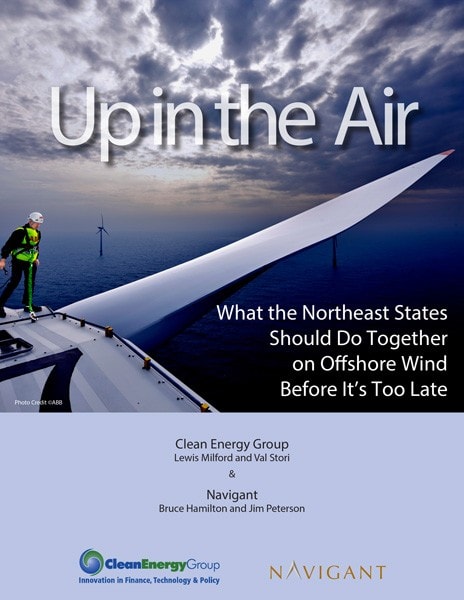February 17, 2015
A Call for Multi-State Collaboration for Offshore Wind
By Lewis Milford
 The disappointing news that the Cape Wind Project might never be built highlights a stark conclusion: U.S. offshore wind policy isn’t working.
The disappointing news that the Cape Wind Project might never be built highlights a stark conclusion: U.S. offshore wind policy isn’t working.
After nearly fifteen years of planning, policy making, and contentious debate, the 430 MW wind farm off the coast of Cape Cod was dealt a sharp blow this past January when National Grid and Northeast Utilities terminated their power purchase agreements. Cape Wind was the first offshore wind project proposed in the U.S., and it was poised to be the first built. But now that bold vision for harnessing a robust no-carbon energy resource has been derailed. How can we prevent other offshore wind projects in the United States from going the way of Cape Wind?
A report by Clean Energy Group and Navigant Consulting, Up in the Air: What the Northeast States Should Do Together on Offshore Wind, Before It’s Too Late, contends that the Cape Wind project’s difficulties serve to highlight a larger policy problem—it is almost impossible for any single state to jumpstart the entire U.S. offshore wind industry. The report recommends a multi-state collaboration to create stronger and consistent regional policies, financing actions, and permitting across the Northeast states.
If Northeast states want to reduce the costs of these projects and create offshore wind jobs, they must develop clear and consistent policies across the region, to give developers good reason to build projects here. If they don’t act together soon, they will lose this clean energy resource for decades to come, which will be bad for the economy and the environment.
These states must work together to develop mechanisms to overcome the major barriers associated with such projects, specifically, high capital costs, lack of infrastructure (e.g., transmission, ports) and regulatory issues, according to Bruce Hamilton, director with Navigant’s Global Energy Practice and one of the report’s co-authors.
The paper is a call to action and recommends states in the Northeast to consider seven multi-state policy areas for regional action.
- Regional Offshore Wind Target. The establishment of a practical regional target (or target range) for offshore wind capacity would produce meaningful economic development and environmental benefits by creating a clear demand signal to developers.
- Coordinated Policy Incentives. Individual state policy drivers, including any incentives for developers, should be consistent across the region to drive demand and produce cost reductions over time through scale up of the offshore wind resource.
- Financing. States should develop new, regional financing mechanisms for regional and single projects, including use of bonds and green bank financing.
- Procurement. States should jointly procure power from one or more large offshore wind projects to reduce costs and create a reliable pipeline of demand for project developers.
- Economic Development. Coordinated, multi-state, economic development strategies rather than purely competitive action would spur economic development activity in the region through the creation of clean energy jobs and potentially new manufacturing facilities.
- Transmission. States should develop joint public funding of regional transmission and interconnection facilities associated with regional projects.
- Permitting. It is essential to the success of the multi-state projects that the policies ultimately adopted for permitting these facilities be standardized.
The paper also recommends consideration of various implementing mechanisms for these policies to be adopted, including a multi-state buyers’ consortium, a state acting on behalf of other states as a bargaining agent, or an offshore wind authority.
New England governors have argued for joint procurement and investment in fossil fuels, natural gas infrastructure, and for more imports of Hydro-Quebec power from massive dams in Canada. But there has been no serious regional policy effort to support offshore wind.
Clean Energy Group hopes that the Northeastern states will soon begin a multi-year process to consider how to pursue these collaborative regional strategies and the resulting environmental and economic benefits, so that the offshore wind potential in this region will not be left up in the air.
The full report is available here.
***
See also: Multi-state coordination needed to revive U.S. offshore wind industry, by Elizabeth Harball, Copyright 2015 E&E Publishing, LLC. This article was published in ClimateWire and re-posted with permission of E&E Publishing.














